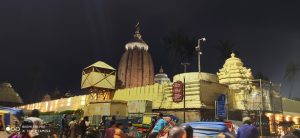Change font size -A A +A ++A

Lord Jagannath at Puri
Bureau Report/
Government’s strategy to counter COVID-19 virus with lock down and subsequently putting patients infected with this virus in quarantine , has achieved success to break the chain of the pandemic Corona at many places in the country. It’s another reason that the disease has started spreading widely, but quarantine is not a new word in the dictionary of ancient medical practices.
Interestingly, country like India already has the system of quarantine. But in practice, the deity who became sick and goes to 14 days quarantine every year!
It was the Persian scholar of medicine, Ibn Sina (980-1037) who first came up with the idea of quarantine to prevent spread of diseases. He suspected that some diseases were spread by microorganisms; to prevent human-to-human contamination, he came up with the method of isolating people for 40 days. He called this method al-Arba’iniya (“the forty”). Hence, the origin of the methods currently being used in much of the world to fight pandemics have their origins in the Islamic world.

Ibn Sina.

Ibn Sina is also known as Abu Ali Sina and often known in the west as Avicenna. He was a Persian polymath who is regarded as one of the most significant physicians, astronomers, thinkers and writers of the Islamic Golden Age, and the father of early modern medicine. In the medical colleges at the western countries, Ibn Sina’s concepts are still relevant in the medical courses.
In India, same theory of keeping a patient quarantine just to prevent the spread of the disease has been following at the same period of Ibn Sina. However, it could not be ascertained whether such practice in India was followed up from Ibn Sina because from reference it is said that the deity, Lord Jagannath himself has the long history of practicing quarantine every year.

Lord Jagannath temple at Puri in Orissa.
Lord Jagannath of Puri Dham in Orissa (one among four Dham in India) every year after Shana Yatra falls sick. The priests of the temple use to remove the idol of the Lord in a dark room and put him in 14 day’s quarantine. During the period no devotee is allowed to visit the deity and no Bhog ( testy rice and different vegetable curries) is allowed at the time to the deity. Only liquid foods like Barlee and juices.

The deity of Lord Jagannath.Ravishanker Kumar Choudhary, a faculty of history at Tilka Manjhi Bhagalpur University has claimed that Ibn Sina is contemporary of the Jagannath temple of Puri. He pointed out that Jagannath temple in Puri , Orissa was built by Ganga dynasty King Anantavarman Chodagagna in the 12th century CE, as suggested by the Kendupatna copper-plate inscription of the descendant of King Anantaverman, Narasimhadeva. Anantaverman conquered the Utkal region (in where the temple is located) in 1112 CE. A 1134-1135 inscription records the donation to the temple by the king. “Hence we have the evidences that this practice was started at two different places almost in the same time,” Choudhary pointed out.



Leave a Reply